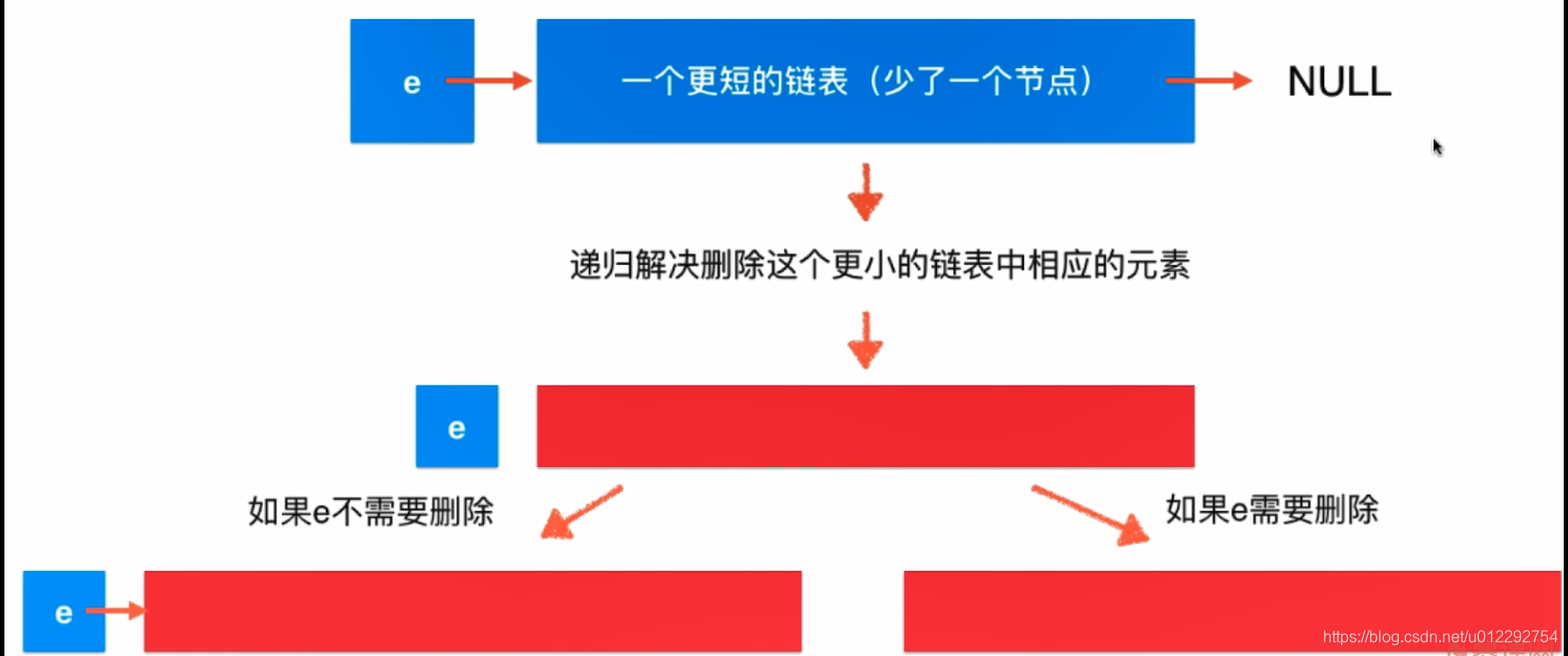版权声明:本文为博主原创文章,未经博主允许不得转载。 https://blog.csdn.net/u012292754/article/details/86708695
1 递归求解 leetcode第203
1.1 递归测试
- 递归的要素

package linked_list_leetcode;
/*
*
* 用递归的方式算 arr 数组的和
* */
public class Sum {
public static int sum(int[] arr) {
return sum(arr, 0);
}
// 计算 arr[l...n] 这个区间内所有数字的和
private static int sum(int[] arr, int l) {
if (l == arr.length) {
return 0;
}
return arr[l] + sum(arr, l + 1);
}
public static void main(String[] args) {
int[] nums = {1, 2, 3, 4, 5, 6, 7, 8};
System.out.println(sum(nums));
}
}
1.2 链表去除元素递归法

class ListNode {
int val;
ListNode next;
ListNode(int x) {
val = x;
}
public ListNode(int[] arr) {
if (arr == null || arr.length == 0) {
throw new IllegalArgumentException("arr can not be empty!");
}
this.val = arr[0];
ListNode cur = this;
for (int i = 1; i < arr.length; i++) {
cur.next = new ListNode(arr[i]);
cur = cur.next;
}
}
@Override
public String toString() {
StringBuilder res = new StringBuilder();
ListNode cur = this;
while (cur != null) {
res.append(cur.val + "->");
cur = cur.next;
}
res.append("NULL");
return res.toString();
}
}
public class RemoveElements_203 {
/*
* 使用递归方式
* */
public static ListNode removeElements4(ListNode head, int val) {
if (head == null) {
return null;
}
ListNode res = removeElements4(head.next, val);
if (head.val == val) {
return res;
}else{
head.next = res;
return head;
}
}
/*
* 使用递归方式
* */
public static ListNode removeElements5(ListNode head, int val) {
if (head == null) {
return null;
}
head.next = removeElements4(head.next, val);
return head.val == val ? head.next : head;
}
public static void main(String[] args) {
int[] nums = {1, 2, 6, 3, 4, 5, 6};
ListNode head = new ListNode(nums);
System.out.println(head);
removeElements3(head, 6);
ListNode res = removeElements4(head, 6);
System.out.println(res);
}
}
1.3 递归调用解读

1.4 递归的打印调试
package linkedlist.digui;
class ListNode {
int val;
ListNode next;
ListNode(int x) {
val = x;
}
public ListNode(int[] arr) {
if (arr == null || arr.length == 0) {
throw new IllegalArgumentException("arr can not be empty!");
}
this.val = arr[0];
ListNode cur = this;
for (int i = 1; i < arr.length; i++) {
cur.next = new ListNode(arr[i]);
cur = cur.next;
}
}
@Override
public String toString() {
StringBuilder res = new StringBuilder();
ListNode cur = this;
while (cur != null) {
res.append(cur.val + "->");
cur = cur.next;
}
res.append("NULL");
return res.toString();
}
}
public class RemoveElements {
/*
* 使用递归方式
* */
public static ListNode removeElements(ListNode head, int val, int depth) {
String depthString = generateDepthString(depth);
System.out.print(depthString);
System.out.println("Call: remove" + val + " in " + head);
if (head == null) {
System.out.print(depthString);
System.out.println("Return: " + head);
return head;
}
ListNode res = removeElements(head.next, val, depth + 1);
System.out.print(depthString);
System.out.println("After remove " + val + " : " + res);
ListNode ret;
if (head.val == val) {
ret = res;
} else {
head.next = res;
ret = head;
}
System.out.print(depthString);
System.out.println("Return: " + ret);
return ret;
}
private static String generateDepthString(int depth) {
StringBuilder res = new StringBuilder();
for (int i = 0; i < depth; i++) {
res.append("--");
}
return res.toString();
}
public static void main(String[] args) {
int[] nums = {1, 2, 6, 3, 4, 5, 6};
ListNode head = new ListNode(nums);
System.out.println(head);
ListNode res = removeElements(head, 6,0);
System.out.println(res);
}
}
1->2->6->3->4->5->6->NULL
Call: remove6 in 1->2->6->3->4->5->6->NULL
--Call: remove6 in 2->6->3->4->5->6->NULL
----Call: remove6 in 6->3->4->5->6->NULL
------Call: remove6 in 3->4->5->6->NULL
--------Call: remove6 in 4->5->6->NULL
----------Call: remove6 in 5->6->NULL
------------Call: remove6 in 6->NULL
--------------Call: remove6 in null
--------------Return: null
------------After remove 6 : null
------------Return: null
----------After remove 6 : null
----------Return: 5->NULL
--------After remove 6 : 5->NULL
--------Return: 4->5->NULL
------After remove 6 : 4->5->NULL
------Return: 3->4->5->NULL
----After remove 6 : 3->4->5->NULL
----Return: 3->4->5->NULL
--After remove 6 : 3->4->5->NULL
--Return: 2->3->4->5->NULL
After remove 6 : 2->3->4->5->NULL
Return: 1->2->3->4->5->NULL
1->2->3->4->5->NULL
Process finished with exit code 0